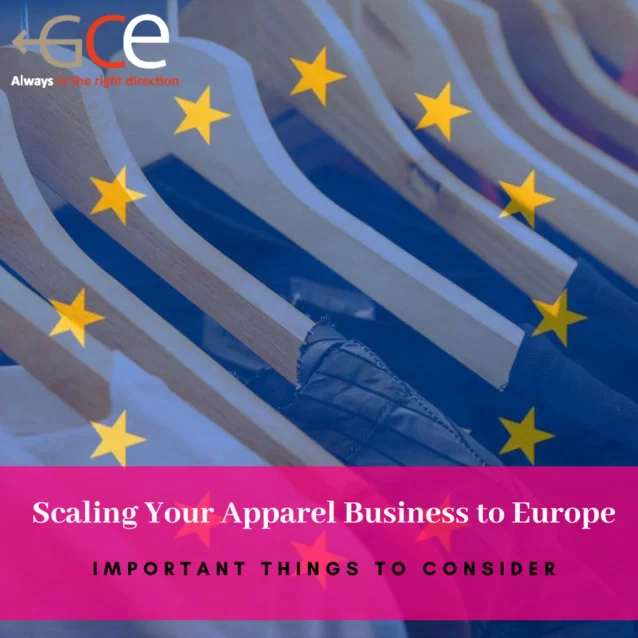Scaling Your Apparel Business to Europe
The European apparel landscape is one of the trickiest consolidated markets for overseas businesses. It is highly segmented, works with strict compliance measures, and doesn’t have a steady supply-demand equation all the time. Therefore, it has never been easy for Asian garment exporters to introduce their goods to Europe.
If you are a MENA-based garment manufacturer and looking to get your products to the European markets, then you have to do some groundwork first to make your entry smooth and gainful. Randomly venturing into any European market with your apparel shipping can prove to be a counterproductive decision. In this piece, we are going to discuss the factors you need to consider before finalizing your plan to scale your apparel business to the European market.
Identify/Build Your Apparel USP First
This is the most crucial step you have to take for venturing into the European apparel market. Europe is the premium marketplace for garment exporters from all over the world. There is a lot of competition going on there. That’s why your business needs to have a Unique Selling Point (USP) to find its feet in the European market with its clothes shipping. So, how you can build and identify your business’s USP? Let’s try to understand this with the help of an example.
Market Research
Let’s suppose you make apparel items from polyester-based fabric in your manufacturing complex in Egypt and want to reach out to European wholesalers and retailers. First, you have to search which polyester-based apparel is most popular in the European market. You also need to narrow down this research to countries.
After taking the popularity and demand of different polyester clothing items in the different European sub-markets into account, you need to look at the manufacturers that are supplying them. This research will give you a clear picture of how to devise the USP of your apparel shipping to the overseas market.
Let’s say you have found out that polyester-based sportswear is in great demand in the UK and the Scandinavian region. Now, you have to lock in that part of Europe as your target market.
Now, the USP that you can go with is “high quality at a low price.” As mentioned earlier, maintaining the binary of quality compliance is a major prerequisite for entering the consolidated European market. So, you have to make sure the polyester apparel you are manufacturing is on par with the vendors already supplying your target market.
After that, you have to offer your goods at a relatively lower price. This strategy doesn’t entail hefty profits in the beginning. However, this will help you establish your place in the market and will facilitate the expansion of your clientele.
You can also take other approaches to develop your business USP for the European apparel market. For instance, you can focus on the Middle Eastern diaspora in your target market with traditional apparel items. There are strong chances that you won’t experience cut-throat competition in this particular niche.
In short, having a USP is an essential element to make your apparel shipping venture a success in the European market.
Factor in the Purchasing Power of the Market
The European apparel market doesn’t have a homogeneous buying tendency and purchasing power. So, you also need to factor in the purchasing power of the segment of the market you are entering. If your manufacturing plant churns only high-end sportswear, then you need to be cautious about the European destination of your apparel shipping.
For instance, France will be a bigger market for your sports apparel than the Netherlands. However, the purchasing power of Dutch nationals is higher than that of French people. This means your apparel shipping has better and brighter prospects in the Dutch market despite the bigger market size of France.
The same matrix of purchasing power applies to the entire Europe. A Norwegian client will be willing to give you a higher price for the same apparel shipment than an Italian client just because of the difference in the purchasing power of the end consumer.
By factoring in the purchasing power of your target market, you can gauge the demand for the apparel you deal in and as well the revenue you are going to earn.
Doing Business with Wholesalers or Retailers
As an overseas garment manufacturer, you have the option to sell to European wholesalers and retailers. You must decide in the beginning whether you want to reach out to wholesalers or retailers. Let’s discuss the prospects of selling to both.
Trading with Wholesalers
Working with wholesalers naturally becomes a better option if you can manage large apparel shipping orders. Doing business with wholesalers and distributors also entails less hassle, especially if you are operating from an overseas location.
Trading with Retailers
Normally overseas garment exporters avoid doing business with retailers because it involves a lot of work. However, there are some instances where reaching out to retailers is also a good business prospect.
- If a retailer is a big apparel brand in the target market, then you must work with them. This won’t just add value to your exporting portfolio, but it will also unlock new opportunities in your home turf (the MENA region).
- If retailers are offering rates where you can easily arrange all the logistical and operational expenses without bearing any brunt on your profit, then there is no harm in doing business with them.
Build Your Compliance Capacity For Apparel
One can’t stress enough how important it is for any overseas garment supplier to comply with the standards set in the European market. No matter how top-quality stuff you produce, you won’t be able to score an apparel shipping contract from a European buyer if you are careless with compliance measures.
You also need to be proactive in this regard. This means you must work with relevant regulatory and auditing bodies to demonstrate your fully compliant working model. Being linked to these compliance monitoring bodies can act as a good promotional tool for your business in the European apparel landscape.
For starters, you can adopt the initiatives regarding chemical safety and implement them in your manufacturing facility. Moreover, having a comprehensively laid-out Corporate Social Responsibility (CSR) development plan can be very helpful in making your business more compliant with European standards in the long run.
The Need for Expert Apparel Shipping Service
Every importing/exporting commodity involves a unique set of shipping requirements for every region. The European ports have their requirements (largely transcribed in the EU laws) for apparel shipping making its way to the European market. Therefore, you need to have garment shipping experts on your team who can iron out all the possible kinks in your apparel shipping.
You don’t have to hire full-time professionals for this. There are expert garment shipping services that can take care of every little detail of consignments comprising clothes. They also take care of all the paperwork related to garment shipments. You just need to furnish those documents (IEC certificates, Wearing Apparel sheets, etc.) to these experts, and they take care of the rest.
Moreover, they can also facilitate you with the particular packaging you need for your apparel shipping to European destinations. They offer regular box shipping for apparel items that fold flat and also GOH (Garment on Hanger) shipping for particular items.
Lastly, they also offer apparel shipping via both air and sea freight. You can choose either of them, depending on your budget, client’s demands, and deadlines. For example, you can opt for air freight to make sure you can deliver an order on time. Similarly, sea freight offers you a more economical and sustainable means to establish a supply chain to the European market.
By mulling over all the above-discussed things, you will be able to better strategize your entry into the European apparel landscape as a garment producer from the MENA region.
Read our Related Articles


Recent Comments